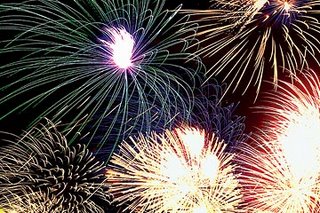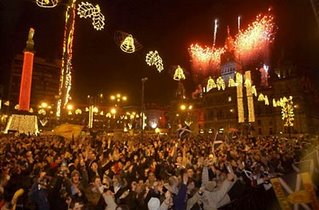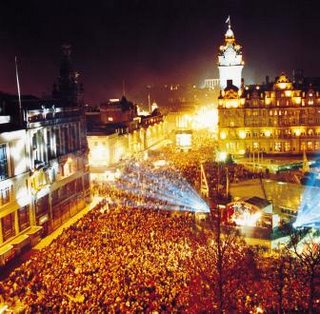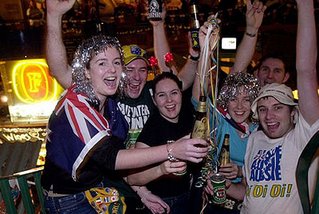Hogmanay
There is only one place to cele brate the New Year in Europe and that’s at the “home” of New Years Eve - Edinburgh. “Hogmanay” as it is known locally, has always been much more than an excuse to have a party for the Scots. It is more of a national festival that has to been see to be believed. Edinburgh annually hosts the biggest New Years Eve party in Europe - and this year it is going to be massive!
brate the New Year in Europe and that’s at the “home” of New Years Eve - Edinburgh. “Hogmanay” as it is known locally, has always been much more than an excuse to have a party for the Scots. It is more of a national festival that has to been see to be believed. Edinburgh annually hosts the biggest New Years Eve party in Europe - and this year it is going to be massive!Edinburgh's Hogmany is a four day free for all celebrating the new year. Visitors enjoy 4 days of fabulous events throughout the city including well loved favourites such as the Torchlight Procession and the world famous Royal Bank Street Party, as well as many new events.

What is Hogmanay?
Hogmanay is the Scots word for the last day of the year and is synonymous with the celebration of the New Year in the Scottish manner. Its official date is the 31 December. However this is normally only the start of a celebration which lasts through the night until the morning of the 1 January or, in many cases, 2 January.Hogmanay is celebrated on New Year's Eve, every year, usually in a most exuberant fashion in Scotland as hundreds of thousands of revellers take to the streets to see in the New Year. Celebrations start in the early evening and reach a crescendo by midnight. Minutes before the start of new year, a lone piper plays, then the bells of Big Ben chime at the turn of midnight, lots of kissing, and everyone sings Auld Lang Syne. And then there is more kissing. Elsewhere in Scotland, particularly in more remote parts, customary first footing and Scottish dances, or ceilidhs (pronounced "kayli"), take place. For centuries, fire ceremonies -- torch light processions, fireball swinging and lighting of New Year fires -- played an important part in the Hogmanay celebrations. And they still do.
What are the origins of Hogmanay?

Hogmanay's roots reach back to the pagan practice of sun and fire worship in the deep mid-Winter. This evolved into the ancient Saturnalia, a great Roman Winter festival, where people celebrated completely free of restraint and inhibition. The Vikings celebrated Yule, which became the twelve days of christmas, or the "Daft Days" as they became known in Scotland. The Winter festival went underground with the Reformation and ensuing years, but re-emerged at the end of the 17th Century. Since then the customs have continued to evolve to the modern day. It is only in recent years that Hogmanay has been celebrated on such a large scale: the first event of its kind was at "Summit in the City" in 1992 when Edinburgh hosted the European Union Heads of State conference. Edinburgh's Hogmanay festival was so successful that it spawned similar events throughout Scotland for last year's millennium festivities. This year the big three Scottish Ne'er celebrations are Edinburgh's Hogmanay, Glasgow's Hogmanay and Stirling's Hogmanay.
What is the symbolism of fire at Hogmanay?
The flame and fire at Hogmanay symbolises many things. The bringing of the light of knowledge from one year to the next, lighting the way into the next uncharted century, putting behind you the darkness past, but carrying forward its sacred flame of hope and enlightenment to a better parish, and in this day, world.
What is First Footing? Traditionally, it has been held that your new year will be a prosperous one if, at the strike of midnight, a "tall, dark stranger" appears at your door with a lump of coal for the fire, or a cake or coin. In exchange, you offered him food, wine or a wee dram of whisky, or the traditional Het Pint, which is a combination of ale, nutmeg and whisky. It's been sugggested that the fear associated with blond strangers arose from the memory of blond-haired Viking’s raping and pillaging Scotland circa 4th to 12th centuries. What's more likely to happen these days is that groups of friends or family get together and do a tour of each others' houses. Each year, a household takes it in turn to provide a meal for the group. In many parts of Scotland gifts or "Hogmananys" are exchanged after the turn of midnight.
 Where is the biggest Hogmanay street party?
Where is the biggest Hogmanay street party?Edinburgh and Glasgow both have street parties for 100,000 people. This is even though the capital is less populated than Glasgow, around 450,000 compared to 750,00 people. However, although last year 100,000 tickets were distributed for the Edinburgh Hogmanay street party, a lot more people found their way in. The biggest Hogmanay street party in Scotland to date was an estimated 300,000 at Edinburgh's Hogmanay in 1996/97 (so they say). It was too many, people were crushed, and it consequently became a ticketed event.
What are the words to Auld Lang's Syne? The words that many of us join hands and sing at the strike of midnight are written in old Scots, the language commonly spoken in Scotland until 1707 when Scotland's Parliament dissolved itself and was merged with England. The words were adapted by Rabbie Burns, Scotland's National poet, from a traditional poem.
Take a deep breath now:
Should auld acquaintance be forgot, And never brought to mind? Should auld acquaintance be forgot, And auld lang syne?
For auld lang syne, my dear, For auld lang syne, We'll tak a cup o'kindness yet For auld lang syne!
If Hogmanay takes your fancy check our tours available at:http://www.backpackertours.co.uk/britain_uk_england_tours/edinburgh-hogmanay-tour.htm
At: www.backpackertours.co.uk

0 Comments:
Post a Comment
<< Home